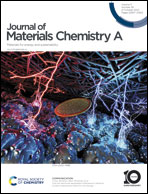Improvement of the Li metal-electrolyte interfacial stability by cis–trans polar conformer formation in a carbonate electrolyte†
Abstract
With the modulation of the Li-salt, linear carbonate solvents undergo spontaneous transformation of the molecular structure as a consequence of an electrolyte engineering process to improve the cathodic stability of the carbonate electrolyte. The cis–trans dimethyl carbonate (ctDMC) electrolyte has a higher lowest unoccupied molecular orbital (LUMO) energy level than the typical cis–cis DMC (ccDMC), which suggests that controlling the salt concentration can enhance the reduction stability of carbonate electrolytes due to a LUMO shift. The shifted LUMO level promotes the nucleation-growth of the Li deposits by reducing the development of an SEI layer on the Li metal and increasing the charge transfer kinetics. While severe electrolyte consumption is demonstrated with conventional carbonates from porously grown lithium and the limited cathodic stability of the bulk electrolyte, dense Li deposits are formed with the conformer electrolyte, which reduces the electrolyte decomposition on the deposited Li surface. As a consequence, the conformer-based electrolyte is used to demonstrate lithium metal battery cycleability associated with a high areal capacity positive electrode.



 Please wait while we load your content...
Please wait while we load your content...